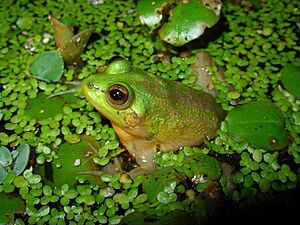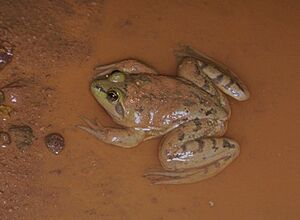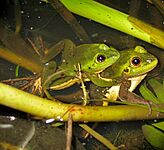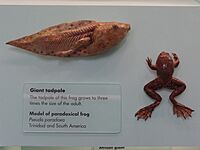Pseudis paradoxa facts for kids
Quick facts for kids Pseudis paradoxa |
|
|---|---|
 |
|
 |
|
| Two different colors of the frog: above – from Mana, French Guiana |
|
| Conservation status | |
| Scientific classification |
The Pseudis paradoxa, often called the paradoxical frog or shrinking frog, is a type of hylid frog found in South America. Its name comes from its amazing life cycle. The tadpole (baby frog) of this species is super big – it can grow up to 27 centimeters (about 10.6 inches) long! This makes it the longest tadpole in the world. But here's the paradox: when this giant tadpole changes into an adult frog, it "shrinks" to only about a quarter or a third of its original length. So, a huge tadpole becomes a regular-sized frog!
Where They Live
These frogs live in ponds, lakes, and lagoons. You can find them in places like the Amazon area, the Guianas, Venezuela, and Trinidad. They also live in some parts of Colombia.
Appearance and Life
Adult paradoxical frogs are usually between 3.4 and 7.6 centimeters (about 1.3 to 3 inches) long. They can be green or brown with darker stripes or spots. Their patterns and colors can change a lot from one frog to another.
The female frog lays her eggs among water plants. These eggs then hatch into tadpoles. These tadpoles always grow very large. However, their final size can depend on where they live. Tadpoles in big, temporary pools with lots of food and few predators tend to grow much bigger.
The tadpoles mostly eat algae, which are tiny plant-like organisms in the water. Adult frogs are active both day and night. They always stay in or near water. They eat insects like flies, beetles, and butterflies. They also munch on other small creatures like crabs and even tiny frogs.
When a paradoxical frog feels threatened, it has a clever trick. It uses its strong toes, which have an extra joint, to stir up the muddy bottom of the water. This creates a cloud of mud that helps the frog hide from danger. The frog also uses this same trick to find food hidden in the mud at the bottom of lakes and ponds.
Potential Use in Medicine
Scientists have been studying a special substance found on the skin of the paradoxical frog. This substance, called pseudin-2, helps protect the frog from infections. In 2008, scientists found that a man-made version of this substance could help cells in the body produce insulin. Insulin is very important for controlling blood sugar. This discovery means that this special substance from the frog's skin might one day help treat Type 2 diabetes.




